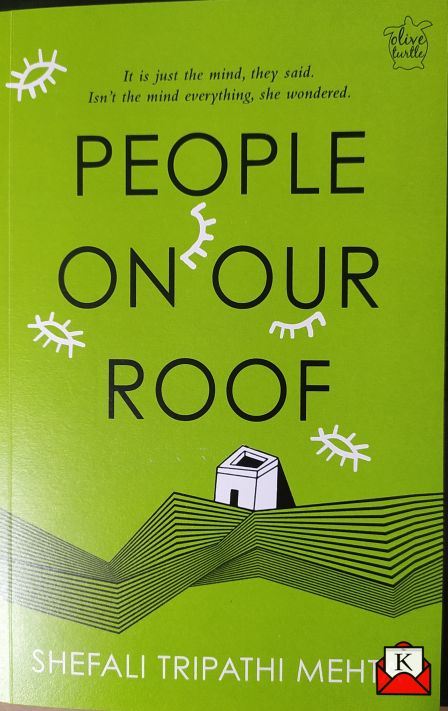“I Am Not In A Hurry To Publish My Next Book”- Author Shefali Tripathi Mehta


Author Shefali Tripathi Mehta lives in Bangalore and works at the Azim Premji University. She also volunteers with the disability organization named Arushi and also curates Gond art for supporting tribal artists. “People on Our Roof” is her second work of fiction. The Kolkata Mail correspondent Priyanka Dutta caught up with the author in an exclusive chat to know more about this book. Excerpts..
This is your second work of fiction. Why did you choose a psychological premise for this second work?
Shefali Tripathi Mehta-Isn’t the working of our minds so intriguing? And though every mind is different, we humans have a sense of ‘normal’ (neurotypical) and any deviation from it is considered ‘abnormal’. We are rather intolerant and insensitive when it comes to people who behave differently. How ironical that there is little social censure of, say, rash driving that has a potential to hurt others or of those who misappropriate public funds, but completely alienates those who think or behave differently and their families. So, while at one level all stories are about how our minds work, I chose to tell the story of how deep the stigma of mental illness runs in our society. The story is not about mental health issues but of how these impact the family, specifically, the protagonist, Naina, a 23-year-old who is shouldering the responsibility of caring for her mother who has schizophrenia, and her younger sister who has autism.
Why the book is named- People on Our Roof?
Shefali Tripathi Mehta- At one level, it is a clear reference to the imaginary people that Amma, Naina’s mother, sees on the roof of their home. It points to her delusions and hallucinations as someone who has schizophrenia. But in a more abstract, symbolic sense, the title refers to the fact that there are people who live in our heads, that is, the control we give to other people and how we in our minds perceive the thoughts and actions of the people around us. So we believe that someone is acting out of jealousy for us or someone is setting us up for failure. We let them all live in our heads and are never free from their ‘influence’ on our lives.
Do you think that mental illness is still hushed away in our country as if it is taboo?
Shefali Tripathi Mehta-Certainly, and because it is a taboo topic, it makes families live in denial of the fact, which stops them from seeking professional help for their loved ones without which they continue to live their constrained, unfulfilled lives. It’s a vicious circle of ignorance and suffering for those who have mental illnesses and their families.
How do you think mental illness should be addressed so as to reach out to more people suffering from this ailment?
Shefali Tripathi Mehta- Awareness, sensitivity, and inclusion are key. We need to understand mental illnesses better. Children are learning about differences – race, ethnicity, even socio-economic disparities and it is heartening that conversations around the inclusion of people with physical disabilities are also being initiated in schools. How some minds work differently should follow. The focus should be on what people with mental illnesses can do rather than on what they cannot.
You work with the disability organization Arushi. How fulfilling is this volunteering?
Shefali Tripathi Mehta- It is because of my association with Arushi’s work with people with physical and mental illnesses that I understand these better. I understand why inclusion is important or why exclusion is detrimental not only to those who have these difficulties but to society as a whole. Each child or person who comes there and learns to live happily, confidently, and independently makes a huge difference to their family. Some of the transformations have been so magical – there are children who were living completely dependent lives, but have after therapy been placed in schools with neurotypical children and they have bloomed to their full potential topping in academics, becoming leaders and class monitors.
Tell us something about Gond art and your association with this art to help the tribal people.
Shefali Tripathi Mehta- Gond art by the tribal artists of central India depicts their lives lived close to nature; they revere elements of nature that sustain their lives – trees and animals. It used to be a gentle, harmonious life, with both man and nature, taking just enough of each other to sustain themselves. A balance that has gone askew. Tribal artists have moved to large cities for livelihoods and not very successfully in these times of online platforms selling cheaper prints of their mesmerizing art, with no care for credits or copyrights. And while these artists have had to adopt city lifestyles, they remain at the periphery of our social structures.
The magic realism of their art is spellbinding – how deer antlers turn into trees or the branches of a tree become the tresses of the Van Devi (goddess of the forest). I try to bring this art form closer to us city dwellers; to those who can appreciate their art and support these artists.
You write on issues like travel, parenting, social issues, and disability awareness. Which among these four do you think is the most challenging to write on?
Shefali Tripathi Mehta- I only write what I feel strongly about so I won’t say one issue is more challenging than another. The challenging part is in the treatment – the voice in which one writes. To constantly check one’s voice, to write to gently nudge, to present facts with as much honesty and sensitivity as one can. Takeaways are important for me as a reader and as a writer, so I always make sure I include those in my writing.
What advice will you like to give to new writers?
Shefali Tripathi Mehta- I read a lot of writing advice. Night-owling, writing long-hand, etc don’t’ work for me. So, find out what works for you.
This is what worked for me. Be patient. Don’t be in a hurry to publish. Don’t be disheartened by rejections – easier said than done – use the opportunity to revisit your work, you grow every day!
Write every day, even if it is a journal entry. Read every day. If there are lean periods, do not fret, keep at it. Don’t compare yourselves with another writer, each one’s journey is their own. Be kind to other writers and grateful for every bit of encouragement and praise you receive.
What also works for me is writing part-time. Writing itself can be a solitary vocation, but it’s in being out there, meeting people, and experiencing things that you add to your repository of writing material. If you are not writing because you can’t find the time for it, maybe you aren’t ready for it yet. Long walks are immensely useful.
What is next in line for you as a writer?
Shefali Tripathi Mehta – A story is sloshing around in my head, I’ll write it when it’s ready. I’m in no hurry to publish another book, and I’d much rather it is a work that I cherish.
The book is priced at Rs 395.
This work of fiction will surely make for a good read for the readers!!
